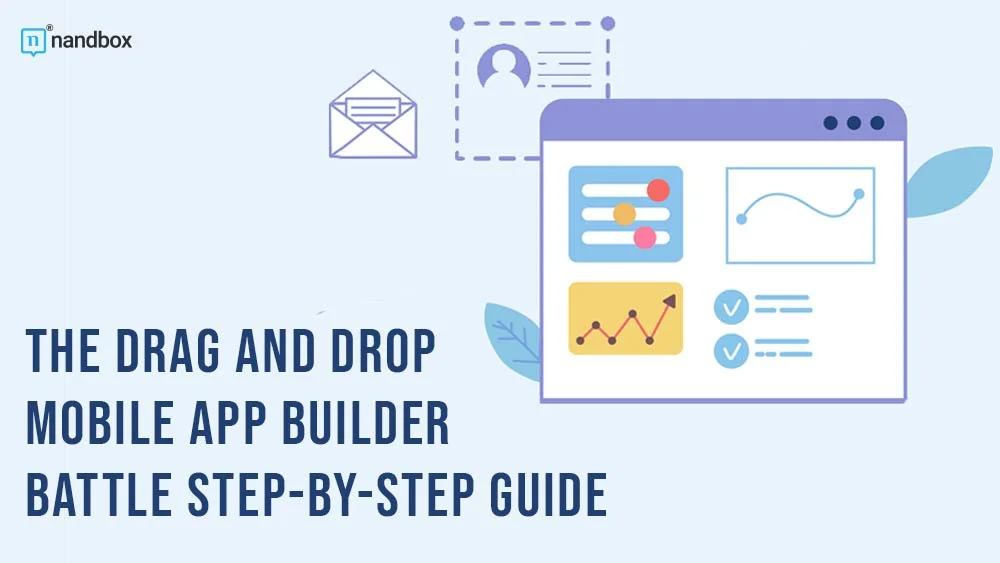The Future of App Development: Drag and Drop Mobile App Builders
The democratization of technology has brought us, as individuals who have a great interest in technology and app development, many advantages. Now people have more broad access to different tools and resources that make them more knowledgeable of tech advancements. One of the things that people have become very fond of is app development. The presence of app-building tools has been a great aid in allowing everyone to experience the exciting process of app-building. One of these important tools is drag-and-drop mobile app building. In this article, we will shed light on such exciting tools and how they make both developers’ and users’ lives easier. By the end of this article, you will be capable of choosing the most suitable drag-and-drop mobile app builder for you to create the best apps.
What is a Drag-and-Drop Mobile App Builder?
Now, what exactly are drag-and-drop mobile app builders? Given that many people are not familiar with such tools yet. Drag-and-drop mobile app builders are app-building tools that are based on either low-code or no-code development. These app builders are known for the flexibility and ease of use they offer developers. A drag-and-drop mobile app builder operates on an intuitive interface based on a drag-and-drop mechanism. This means that developers would need to drag and drop elements into the application to apply them. This mechanism has proven to be very effective for developers, as it saves them much effort and time that they usually spend on the traditional app development process and all the coding involved.
Drag-and-drop mobile app builders vary according to the development method. So, for instance, low-code development app builders have a different methodology as some coding would be involved. Using low-code development, developers would drag and drop visual elements or parts to create a function. Therefore, low-code app builders aim to make coding more visual and not textual.
On the other hand, no-code mobile app builders are completely free of any coding involvement. Although no-code app builders also operate using a drag-and-drop interface, all the elements that an individual would need are pre-built and just need to be incorporated.
How Was the Idea of Drag-and-Drop Mobile App Builders Initiated (aka The No Code/Low Code Movement)
We have had a glimpse of the two types of drag-and-drop mobile app builders that users would encounter. But that is not enough. The true question is how the idea of a drag-and-drop mobile app builder started with no code and low-code development.
The first thing you must know is that both movements and development methods were initiated by the need for more RAD, or rapid app development approaches. In 1982, a book was published under the name “Application Development without Programmers” by James Martin. This book evolved around the need for tools that could work with developers in the future and make programming without developers possible. With the rise of the World Wide Web, low-code and no-code solutions started to emerge as the ultimate tools for businesses and individuals. So, for instance, Geocities was the first no-code web-building platform to be launched in 1994. This platform helped people create and host websites on their own. After Geocities’ remarkable success, many no-code web builders launched and created a new era in web development.
It wasn’t until mid-2010 that no code and low code started to get more recognition and started to branch into app development. In light of making matters seamless, these platforms settled for drag-and-drop as the main mechanism to create a more enjoyable and efficient development process. Platforms like Bubble and Zoho Creator were among the first low-code and no-code drag-and-drop platforms to build applications. Following that, the number of drag-and-drop mobile app builders took off and never stopped.
What Should You Look for When Choosing a Drag-and-Drop Mobile App Builder?
What a rich history, am I right? Well, now let us ask a very good question that you will definitely need. Now, with this large number of drag-and-drop mobile app builders, how could you find the best one? Or even better, what should you look for when choosing a drag-and-drop mobile app builder? There are some characteristics and aspects that you should look for first before ever settling on a drag-and-drop mobile app builder, so let us list some together
1.) Ease of Use
Bet you definitely saw this coming. The whole idea behind a drag-and-drop mobile app builder is to be easier than the conventional app development process. It all starts with an easy-to-navigate interface. Easy navigation, drag-and-drop capabilities, and rapid alterations are key features of a user-friendly mobile app builder. With an intuitive UI, even people without a strong background in coding will be able to create their own apps. Streamlining and improving the workflow of a development team can increase productivity, decrease error rates, and shorten development times.
2.) Template Variety and Customization Options
Templates and customization options are a main part of many mobile app builders and one that you should take into consideration when choosing a suitable one for your project. To meet the needs of different app types and businesses, it is vital to have an extensive selection of templates. The purpose of these templates is to provide a foundation upon which you can build. To make sure your app is perfect for your brand and meets all of your specific needs, you should choose a drag-and-drop mobile app builder that lets you customize the layout, colors, fonts, and functionality exactly how you want it to be.
3.) Scalability and Flexibility
When the number of users increases, a developer has to be ready to operate on a larger scale and serve this increasing number seamlessly. This is not possible without the scaling capabilities that a drag-and-drop mobile app builder has to offer. You must prioritize scalability as your app develops. Picking a drag-and-drop mobile app builder that can handle expansion without any big technological problems is essential. As your app grows, you should look for features that make it easy to add new features, databases, or APIs. Because of its scalability, your application can adjust to new features and user needs as technology evolves.
4.) Cost and Pricing Structure
Your budget must come first when choosing a drag-and-drop mobile app builder. And that is why an affordable and reasonable pricing structure should be among your top considerations. Look at the builder’s subscription plans and pricing model from both a short-term and long-term financial perspective. Think about how much it will cost to make the application scalable as it expands. And also compare the features offered by different pricing tiers and make sure they match your app’s requirements and budget.
5.) Customer Support and Update Frequency
Lastly, customer support is something you are going to need extensively, so make sure to consider it. Check the builder’s customer service to see how fast and helpful they are. You should also look into how often the platform rolls out updates and enhancements. The frequent upgrades show the developer’s commitment to staying current with technological advancements and responding quickly to user feedback.
Benefits of Using a Drag-and-Drop Mobile App Builder for App Developers
Maintenance and Updates
It is common for drag-and-drop builders to take care of backend upgrades and maintenance, freeing developers from handling servers and other technical tasks. The developers can then devote more time to making the application better for users and adding new features instead of fixing bugs and doing other normal maintenance.
Integration with Third-Party Services
A lot of drag-and-drop mobile app builders include connections with other third-party services already integrated, like analytics, social networking, payment gateways, and more. Because of this, developers may add features to the app without having to write a ton of code, which streamlines the integration process.
Flexibility and Customization
Even though drag-and-drop builders have a less complicated user interface, they usually give a lot of customization options. By adjusting settings, incorporating APIs, or adding customized code as needed, developers can customize the app’s appearance, functionality, and features. Because of this adaptability, customized solutions can be created to fulfill the needs of individual projects.
Accessibility to Non-Technical Users
These builders make app development accessible to everyone by allowing those without significant coding skills to design their apps. Lessening the need for specialized developers and development expenses, these user-friendly interfaces make it possible for entrepreneurs or non-technical users with minimum technical knowledge to design and construct apps.
Collaboration and Team Effort
It’s not uncommon for drag-and-drop builders to have collaboration tools that let numerous team members work on the app at the same time. Because this allows team members to collaborate and share remarks and suggestions in real-time, it improves communication, speeds up development, and encourages teamwork.
Reduced Debugging Time
These builders can help reduce errors and flaws by providing better visual illustrations of the app’s parts and layout. The development process runs more smoothly and efficiently since developers may find and fix problems while they’re still in the development phase.
Exploring the Drag-and-Drop Mobile App Builder Battle: Comparing the Best
The battle between mobile app builders gets fiercer and fiercer each day. The comparison also gets harder given that these platforms are always on the run to implement the latest technologies and enhance their capabilities. However, for this comparison, we are going to rate three of the top drag-and-drop mobile app builders based on the characteristics we have mentioned above.
1.) nandbox
Firstly, nandbox is a leading drag-and-drop mobile app builder and the only native app builder on the market as well. Since its launch in 2017, it has taken off due to its many capabilities and advanced features.
Ease of Use: The intuitive drag-and-drop mechanism and interface make nandbox very easy to use. Developers can easily explore the app builder and learn everything, thanks to the video tutorials and detailed documentation.
Template Variety and Customization Options: Nandbox offers a varied list of templates for all categories, such as communication and e-commerce. Each category has a large number of templates with exact replicas of popular apps like Amazon.
Scalability and Flexibility: Scalability is easily accomplished with nandbox. It opens the door for sophisticated app development with deep backend integrations and customizations, thanks to its scalability and flexibility. Complex projects may necessitate more technical knowledge, but it’s great for developing apps with a lot of scalability.
Cost and Pricing Structure: Nandbox has three pricing plans in addition to the free one. the basic for $49, the professional for $139, and the premium for $299. Compared to the previous app builder, nandbox is on the very affordable side.
2.) Bubble
Since Bubble is among the first mobile app builders on the market, we had to mention it in our comparison. Bubble launched in 2012 and started by allowing people to build web apps, and they will soon expand into native apps.
Ease of Use: Bubble is very easy and seamless to use, with walkthroughs for the whole building process as well as detailed guides
Template Variety and Customization Options: Although Bubble has a rich list of templates, not all of them are free. Bubble limits the number of unique templates people can buy, and only the basic templates are free. As per customization, Bubble offers many customization options when it comes to UI, where developers can customize fonts, styles, colors, and so on.
Scalability and Flexibility: Scalability is not so easy for Bubble, as they limit scalability unless you pay for a specific number of users, which makes scalability somewhat hard for developers through Bubble.
Cost and Pricing Structure: Bubble has five pricing schemes: free, starter for $29, growth for $119, team for $349, and the last for big projects and enterprises. Adalo’s pricing scheme is considered a bit expensive given that what a starter plan offers is very limited and to shift to a bigger plan, there would be a major difference.
3.) Adalo
Adalo is one of the latest mobile app builders to launch in recent years. However, it has proven to be very effective and offers many capabilities that have attracted millions of users.
Ease of Use: Adalo is very clear when it comes to usage and building apps. However, it lacks the walkthrough and guide that Bubble offers, which can be confusing for some users.
Template Variety and Customization Options: Adalo doesn’t have a template variety and only offers five templates, including a blank one.
Scalability and Flexibility: Adalo can be pretty scalable depending on your plan, as each has its limitations in terms of the number of users and data storage. However, it is easily scaled with add-ons.
Cost and Pricing Structure: Adalo has four plans in addition to the free one. The starter is $45, the professional is $65, the team is $200, and the business is $250. Adalo’s plans, in comparison to Bubble, are affordable, and each offers many capabilities.






